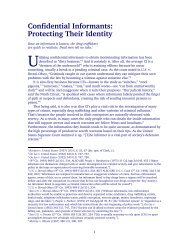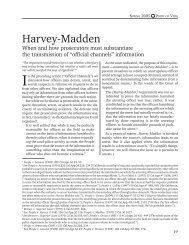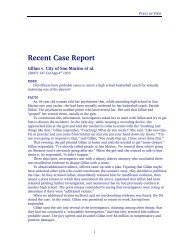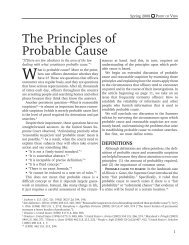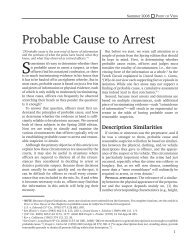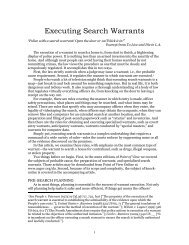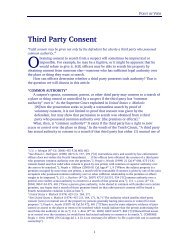Protecting Surveillance Sites - Alameda County District Attorney's ...
Protecting Surveillance Sites - Alameda County District Attorney's ...
Protecting Surveillance Sites - Alameda County District Attorney's ...
Create successful ePaper yourself
Turn your PDF publications into a flip-book with our unique Google optimized e-Paper software.
If a defendant seeks the disclosure of a surveillance location which officers<br />
want to remain secret, prosecutors must respond by explaining, (1) why<br />
disclosure of the surveillance location falls within the “official information”<br />
privilege, or (2) declare they cannot provide such an explanation in open court<br />
without betraying the privilege.” 22<br />
The defendant then has the burden of demonstrating there is a reasonable<br />
possibility that knowledge of the exact location of the surveillance site is material<br />
on the issue of the defendant’s guilt. 23 If the defendant meets this burden, the<br />
court will conduct an in camera hearing. 24 The defense may submit questions to<br />
be asked at the hearing. 25<br />
The purpose of an in camera hearing is to determine if the need for disclosure<br />
is outweighed by the need to preserve the confidentiality of the surveillance<br />
location. 26 Consequently, the prosecution must disclose to the judge the precise<br />
nature of the information obtained from the site 27 and will attempt to prove it is<br />
in the public interest to maintain the confidentiality of the surveillance location.<br />
This may be accomplished by showing that disclosure of the location would put<br />
the occupants or owner in danger of retaliation, threaten the safety of officers<br />
who may use the location in the future, or destroy the usefulness of the location<br />
to officers in the future. 28 Other relevant evidence includes the nature of the<br />
crime charged and possible defenses. 29 In appropriate cases, the prosecution may<br />
attempt to prove the there was no obstructions of the view so as require<br />
disclosure by furnishing the court with a videotape or photograph of the view<br />
taken from the surveillance site. 30<br />
The court will also consider the relevance of the information to the defense<br />
and any available alternatives to full disclosure. 31<br />
1 People v. Walker (1991) 230 Cal.App.3d 230, 235 [quoting from U.S. v. Green (D.C. Cir. 1981)<br />
670 F.2d 1148, 1155].<br />
2 NOTE: Officers have a legal right not to reveal the location of a confidential surveillance<br />
location. See Evidence Code § 1040; People v. Walker (1991) 230 Cal.App.3d 230, 235-8; Hines v.<br />
Superior Court (1988) 203 Cal.App.3d 1231, 1234; In re Sergio M. (1993) 13 Cal.App.4 th 809, 813;<br />
People v. Montgomery (1988) 205 Cal.App.3d 1011, 1018-9 [“We agree that one effect of section<br />
1040 is to establish, under appropriate circumstances, a ‘surveillance location privilege’ in<br />
California.”]; People v. Haider (1995) 34 Cal.App.4 th 661, 665.<br />
3 See People v. Montgomery (1988) 205 Cal.App.3d 1011, 1022; Hines v. Superior Court (1988)<br />
203 Cal.App.3d 1231, 1234-6.<br />
4 People v. Montgomery (1988) 205 Cal.App.3d 1011, 1019 [quoting from U.S. v. Green (D.C. Cir.<br />
1981) 670 F.2d 1148, 1155]. ALSO SEE People v. Walker (1991) 230 Cal.App.3d 230, 235<br />
[“Furthermore, in most cases a surveillance location and consequently the people who have<br />
permitted the use of their property deserve more protection than the informant who has mobility<br />
as a protection against reprisal since a person whose address is revealed has no place to hide.”].<br />
5 People v. Montgomery (1988) 205 Cal.App.3d 1011, 1019. ALSO SEE People v. Haider (1995) 34<br />
Cal.App.4 th 661, 665.<br />
6 See People v. Walker (1991) 230 Cal.App.3d 230, 236; People v. Montgomery (1988) 205<br />
Cal.App.3d 1011, 1020-2.<br />
7 See People v. Garza (1995) 32 Cal.App.4 th 148, 153; People v. Walker (1991) 230 Cal.App.3d 230,<br />
236, 238; People v. Montgomery (1988) 205 Cal.App.3d 1011, 1021. NOTE: Disclosure is not<br />
required merely because the surveillance observations would have been “relevant.” See People v.<br />
Garza (1995) 32 Cal.App.4 th 148, 156; People v. Haider (1995) 34 Cal.App.4 th 661, 669.<br />
8 (1995) 32 Cal.App.4 th 148, 155.



